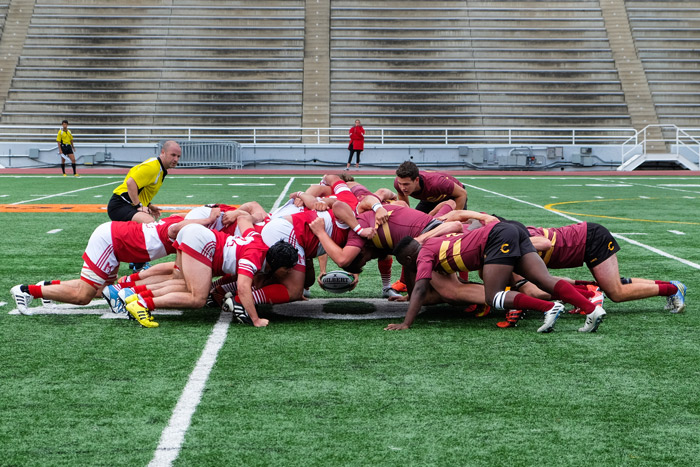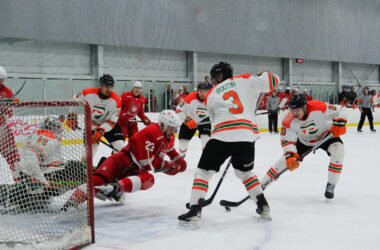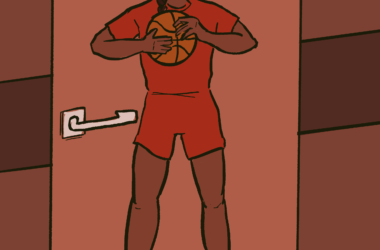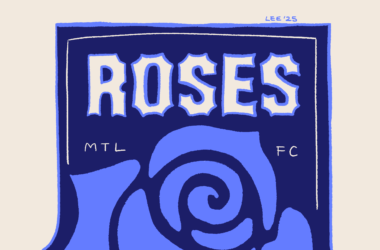When Peter Smith was a McGill athlete in the 1970s, team-building on both Redmen and Martlet teams looked very different than it does today. Now head coach of the Martlet hockey team, Smith remembers a varsity program that was in stark contrast to the recruiting culture of NCAA universities south of the border.
“Back then [in the 1970s], for a lot of teams, there were many more ‘walk-ons’ chosen for rosters from tryout situations […] than recruited players,” Smith said. “Now, although there are exceptions, most of the athletes on varsity teams are highly recruited.”
Recruiting techniques have changed over the past 40 years at McGill and in Quebec more broadly, with the system now falling more in line with the NCAA’s system of attracting talent in the United States by scouting at big tournaments and appealing to star athletes. Like most NCAA schools, McGill offers multiple scholarships for top-tier athletes and has won numerous championship titles over the years—all while maintaining rigorous academic standards. However, wide disparities exist in the support McGill teams are given from McGill Athletics. Often times, McGill’s uncompromising academic standards and limited resources for athletes put its sports teams at a competitive disadvantage in the race to pick up Quebec talent.
McGill’s ability to recruit top talent is reduced because it does not have the financial means to make the lucrative offers that many other schools can. The athletic scholarships available to incoming freshmen range from $1,000 to $6,000, though the maximum award for Canadian students is $3,500. Furthermore, most McGill teams don’t have any financial aid at their disposal to offer athletes. Yet, scholarships only apply to a few sports, and many other universities are able to table more sizable offers. Comparable schools like the University of Toronto (UofT) offer up to $4,500 to athletes, a more attractive offer for some Canadian students. Université Laval, a Canadian sports powerhouse and local rival, can muster Quebec talent for its Rouge et Or teams with awards reaching up to $10,000.
“I know that Laval is strong,” Fourth-year Redmen runner François Jarry said. “If you’re putting in 15 to 20 hours a week, then [money is] probably a key factor [in choosing a school] because you don’t have time to work.”
McGill does, however, make up for some of its shortcomings by leveraging its academic reputation to attract players. As it consistently ranks among Canada’s top universities, McGill has a standard to uphold. Admissions requirements are higher than at any other university in the country. A CEGEP student needs an R score—the measure used by university admissions to rank Quebec students—of at least 25 or 27 to even be considered for McGill, while scores can be as low as 19 at Concordia.
“Student athletes who get into McGill get in through the front door,” Smith said. “Certainly, for our team, that narrows the field definitely. I’ll go watch a game and with [an opposing] team with 16 players on it, [and] there might be four players that have the academic marks to be able to get into McGill, so that’s where we start.”
Even the University of Toronto’s requirements, with an R score somewhere in the mid-20’s, are less contingent on an applicant’s grades. Universities like Concordia and Laval are far more lenient. As a result, competitors—both in terms of academics and location—can recruit on the periphery of McGill’s admissions and accrue more homegrown talent. Not having to rely on international or exchange students makes teams much more secure.
“It’s a good contrast to make between Laval and McGill because [Laval is] very sports-based,” Jarry said. “It’s harder for McGill to recruit sometimes because […] some people […] don’t have the grades.”
Alex Pantis, a second-year Redmen rugby player, attests to the strain McGill’s academic requirements put on McGill teams. Concordia’s ability to recruit athletes who don’t meet McGill’s admissions standards puts the Stingers ahead in team-building, and it showed during this year’s rugby season: Concordia’s rugby team went on to beat McGill in both of their regular-season matches as well as in the RSEQ semifinal.
“Concordia had a very strong team and we’re looking to get back [into championships] next year,” Pantis said. “It’s not like we look at not being able to recruit as the main reason why we can’t [compete] but it’s also a real reason as to why we couldn’t compete with Concordia this year. [Around] 10 of their 13 [RSEQ all-stars] were from Quebec, and those were guys they recruited and brought to Concordia, whereas we had five guys [on all-stars] and only two of us were from Quebec.”
Pantis was one of McGill’s two Quebecois RSEQ all-stars. Jarry is similarly from Quebec. Their accounts as homegrown student athletes highlight McGill’s shortcomings in recruiting. In regards to his experience as a rugby recruit, Pantis stated that the greatest problem seemed to be a lack of consideration for potential McGillians with recruit status.
“[In my experience], it’s just a flag on your application that basically says you’re a recruit that they want for a certain sport, and that’s it,” Pantis said. “It’s very minimal, like if you’re equal to another person like to the hundredth or thousandth decimal, they’ll add […] a plus [to your application], but it’s same standard if you’re part of the environmental club at your high school [….] You can’t [be promised] anything.”
A lax attitude toward prospects in sports such as rugby does immense harm to McGill’s recruiting power. If an applicant’s recruit status ultimately means little in the admissions process, then it can be difficult for prospects to build any kind of identity as a future Martlet or Redmen during preliminary trials with varsity teams. This time of year is also the crucial period when decisions are rolling in from most schools. Prospective McGillians on the edge of the academic bubble are forced to grapple with the uncertainty of their admission status while fighting to establish their place on a McGill team. Meanwhile, those same prospects already have the option to cement their places among teams at rival schools like Concordia because they will most likely get in. By the time the admissions office at McGill communicates a decision, it is often too late. The prospective talent has already walked off to another school.
“Other schools have the liberty to offer [potential athletes] stuff on the team like ‘come to this school because we can get you on the team, we can do this,’” Pantis said. “And [with] McGill, it’s like ‘if you get into the school.’ So people don’t have a chance to buy in fully to McGill Athletics because they don’t have the chance to really wrap their heads around the idea of coming here.”
McGill may not have the resources or incentive to expand its scholarship program, as all universities have a plethora of other priorities to tackle. In the absence of financial means, it touts academic prestige as a recruiting tool to compensate for losses in the monetary battle. This strategy has been effective in some cases, but McGill’s concentrated focus on stringent academic standards and a select few teams prevents it from being the sports powerhouse that it could be. If McGill wishes to bridge its competitive gap in team-building, it must extend financial support to all varsity teams, and recruit status needs to convey a sincere sense of belonging to athletic prospects. Otherwise, McGill will continue to watch exciting talent wear its opposition’s colours.
This article has been updated to provide more context regarding Pantis' personal experience with recruitment.









Thank God someone wrote this article. This is brilliantly written and I agree with this 100%.